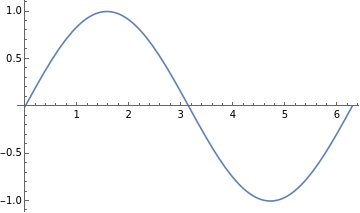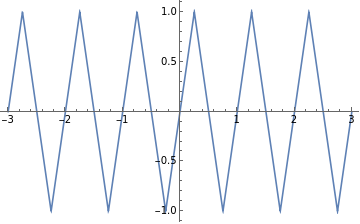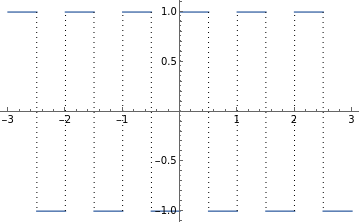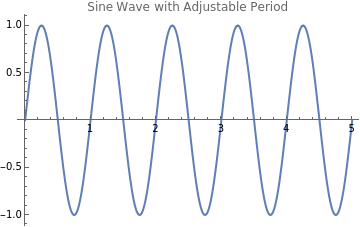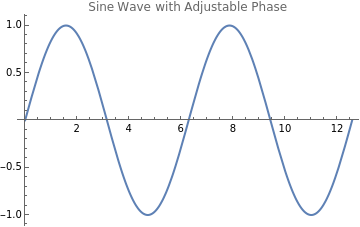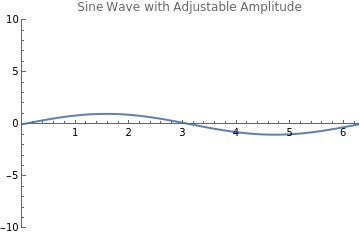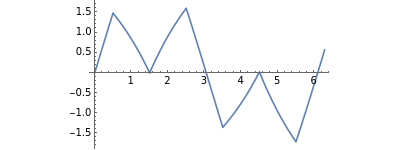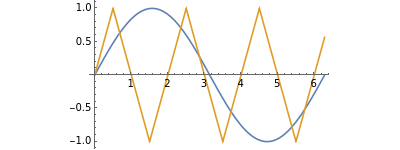Introduction to Quantum Interference
Introduction to Quantum Interference
Interference is an important wave phenomenon - and an essential concept in both classical and quantum physics. In this notebook, we will explore how interference figures in quantum theory.
What is a Wave
What is a Wave
Waves are prominent in the natural world, from water waves to electromagnetic waves. Mathematically, a wave is described by periodic motion.
◼
Sine Wave:
In[1]:=
Plot[Sin[x],{x,0,2Pi}]
Out[1]=
Waves don’t have to be differentiable at every point.
◼
Triangle Wave:
Plot[TriangleWave[x], {x, -3, 3}, ExclusionsStyle -> Dotted]
Out[2]=
In fact, waves don’t even have to be continuous.
◼
Square Wave:
Plot[SquareWave[x], {x, -3, 3}, ExclusionsStyle -> Dotted]
Out[3]=
Wave Properties
Wave Properties
◼
The period b of a wave is how long it takes to complete one full cycle.
In[4]:=
Manipulate[Plot[Sin[2πx/b],{x,0,5},PlotLabel"Sine Wave with Adjustable Period"],{{b,1,"Period"},1,5}]
Out[4]=
◼
The phase ϕ translates the wave horizontally.
In[5]:=
Manipulate[Plot[Sin[x+ϕ],{x,0,4π},PlotLabel"Sine Wave with Adjustable Phase"],{{ϕ,0,"Phase"},0,2π}]
Out[5]=
◼
The amplitude A stretches or shrinks the wave vertically.
In[6]:=
Manipulate[Plot[ASin[x],{x,0,2π},PlotLabel"Sine Wave with Adjustable Amplitude",PlotRange{{0,2Pi},{-10,10}}],{{A,1,"Amplitude"},0.5,10}]
Out[6]=
Combining Waveforms
Combining Waveforms
When two waves are present, the resulting wave is formed by adding their signed amplitudes at each point. Such a resulting wave is called a linear superposition.
In[7]:=
Plot[{Sin[x],TriangleWave[x/2]},{x,0,2π},PlotLegends{"Sin(x)","TriangleWave(x/2)"},ImageSize{400,150}]Plot[Sin[x]+TriangleWave[x/2],{x,0,2π},PlotLegends{"Sin(x)+TriangleWave(x/2)"},ImageSize{400,150}]
Out[7]=
◼
When the signs of the wave amplitudes align, they exhibit constructive interference, and when they oppose each other, they exhibit destructive interference.
Two waves of the same amplitude and period constructively or destructively interfere depending on their relative phase.
◼
Note that they completely cancel each other when they have a relative phase of ϕ = π
The Wave Function
The Wave Function
In quantum physics, particles are mathematically described by wave functions:
◼
Particle in Infinite Square Well:
◼
Particle in Harmonic Oscillator Potential:
Exploring Diffraction
Exploring Diffraction
Here’s where things get interesting: A particle can actually interfere with ITSELF. Let’s see how this happens.
◼
According to Huygens Principle, every point on a wavefront is a source of wavelets.
◼
When a particle passes through a narrow slit, its wavefront propagates radially on the other side of the screen
◼
If we place a screen with two more slits in front of the propagating wave, we get two more wave fronts.
At each point on the back screen, the resulting amplitude is the superposition of the waves propagating from both slits.
◼
The waves travel different distances to get to any point on the back screen, so by the time they get there they are shifted by some phase ϕ.
Conclusion
Conclusion
At points where the two wave-fronts differ by a phase of π, they completely destructively interfere, resulting in 0 probability of observing the particle there. This patently non-classical behavior was one of the first indications that a new model (quantum mechanics) was needed to model certain physical phenomena!
Further Exploration
Investigate single slit diffraction where the slit admits a continuum of wave-fronts
Authorship information
Jacob Marks
2017/06/23
jamarks13@gmail.com
